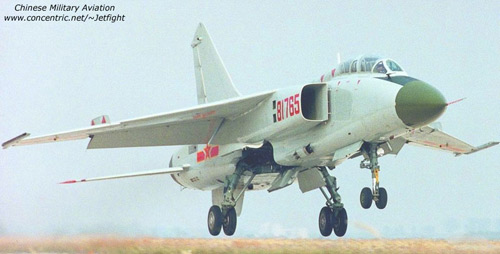JH-7 Flounder
Summary
| Category | Combat Aircraft |
| Origin country | 🇨🇳 China |
| Manufacturer | Xian |
| First flight | 14 December 1988 |
| Year introduced | 1992 |
| Number produced | 270 units |
| Average unit price | $25 million |
Description
In the early 1970s, the People's Liberation Army Air Force identified a need for a new fighter-bomber to replace the Harbin H-5 and Nanchang Q-5. This requirement led the Ministry of Aviation Industry to initiate a domestic development program after failing to establish a joint venture with foreign entities. Formally authorized on 19 April 1983, the program sought to integrate the British Rolls-Royce Spey turbofan engines into the design. The People's Liberation Army Naval Air Force also required a similar aircraft, and the program was designed to produce variants tailored to each set of requirements. While the initial PLAAF variant was envisioned as an all-weather, long-range bomber with advanced electronic countermeasures and terrain-following capabilities, it was eventually dropped in favor of the PLANAF variant, which became the JH-7. By December 1988, six prototypes had been constructed. The first flight of a JH-7 prototype took place on 14 December 1988.
The PLANAF subsequently received an initial batch of 12 to 18 aircraft in the early 1990s for evaluation. These early models were equipped with imported Rolls-Royce Spey Mk.202 engines, later substituted by the license-built WS-9, and featured the Type 243H multifunction radar, capable of detecting ships at a maximum range of 175 kilometers and MiG-21-sized aerial targets at 75 kilometers. The JH-7 was specifically designed as an anti-ship fighter-bomber, its aerial combat capability considered secondary to its primary role.
The improved JH-7A features a lighter and stronger airframe, increasing its maximum ordnance load to 9,000 kg. The JH-7A is equipped with a domestic Chinese helmet mounted sight (HMS), compatible with air-to-air/surface missiles and airborne sensors. Avionics upgrades include the replacement of the Type 960-2 noise jammer with the BM/KJ-8605 and the Type 265A radar altimeter with the Type 271 radar altimeter, along with a fully digitized fly-by-wire flight control system. The Type 232H airborne radar is replaced by the JL-10A pulse-Doppler radar, enabling the JH-7A to fire laser-guided bombs and Kh-31P anti-radiation missiles. The JH-7A has nine hardpoints in total: six under-wing, two at the wing-tips, and one under the fuselage, bringing the total to nine, and a one-piece windscreen replaced the original three-piece windscreen. It can carry up to 9,000 kg (20,000 lb) of external fuel and ordnance. These hardpoints accommodate a diverse array of munitions, including 57mm/90mm unguided rocket pods, various air-to-air missiles such as the PL-5, PL-8, PL-9 and PL-12, anti-ship missiles like the YJ-81, and multiple air-to-surface and anti-radiation missile types including the AKF-98, KD-88, YJ-91, and CM-102. The JH-7A can also deploy a range of bombs, from unguided to laser-guided LT series and GB series, satellite-guided LS and FT series, the GB6 submunition dispenser, and the YJ-1000-1 bunker penetrator. It is also armed with one 23mm twin-barrel GSh-23L autocannon with 300 rounds. The JH-7A was the first Chinese aircraft to use paperless design, utilizing CATIA V5 software.
The first JH-7s were delivered to the PLANAF in the mid-1990s for evaluation, followed by the improved JH-7A entering service in 2004 with both the PLANAF and PLAAF. In 1992, a JH-7 experienced a critical failure during a test flight when its rudder detached at 5,000 meters; the pilot averted disaster by using differential engine thrust to safely return to base, landing with a burst tire but preventing the loss of the aircraft and its payload of live missiles. The JH-7 has also participated in international exercises, including the Shanghai Cooperation Organisation's "Peace Mission" in 2007, and joint naval exercises with Russia in 2012 and 2013.
Main Variants:
-
JH-7: This is the initial production version designed as an anti-shipping fighter-bomber for the PLANAF.
-
JH-7A: An improved variant featuring a lighter and stronger airframe, enhanced avionics including the JL10A Shan Ying J-band pulse-Doppler radar, and increased weapon load capacity.
-
JH-7A2: An advanced version of the JH-7A, it has enhanced air-to-ground munitions and carrying capabilities.
-
JH-7E: This is a possible export variant, showcased at the 2018 Zhuhai Airshow, potentially offering the aircraft's capabilities to international customers.
-
FBC-1 Flying Leopard: This is the export version of the JH-7, aimed at offering the aircraft's capabilities to international customers.
Technical specifications
| Version: JH-7 | |
|---|---|
| Crew | 1 pilot + 1 WSO |
| Operational range | 1,648 km (1,024 mi) |
| Maximum speed | 1808 km/h (1123 mph) |
| Wing area | 52.3 m² (563.0 sqft) |
| Wingspan | 12.8 m (42.0 ft) |
| Height | 6.2 m (20.4 ft) |
| Length | 22.3 m (73.2 ft) |
| Service ceiling | 16,000 m (52,493 ft) |
| Empty weight | 14,500 kg (31,967 lbs) |
| Max. takeoff weight | 28,475 kg (62,777 lbs) |
| Powerplant | 2 x turbojets Xian WS-9 delivering 5557 kgf each |
| Ejection seat | Zvezda K-36DM |
Current operating countries
| Country | Units | ||
|---|---|---|---|

|
China | 103 | |
All operators
Armament
Bombs payload:
- Laser-Guided AVIC LS
